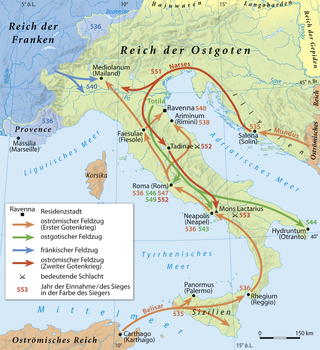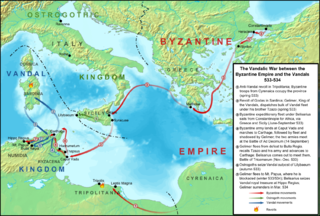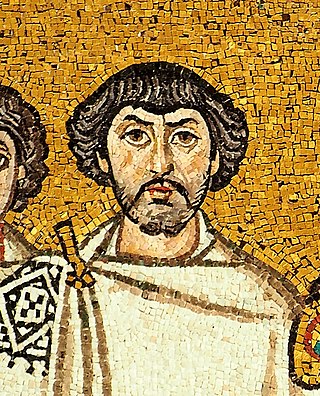Related Research Articles
The 530s decade ran from January 1, 530, to December 31, 539.
The 540s decade ran from January 1, 540, to December 31, 549.
Year 536 was a leap year starting on Tuesday of the Julian calendar. At the time, it was known as the Year after the Consulship of Belisarius.

Year 537 (DXXXVII) was a common year starting on Thursday of the Julian calendar. At the time, it was known as the Second year after the Consulship of Belisarius. The denomination 537 for this year has been used since the early medieval period, when the Anno Domini calendar era became the prevalent method in Europe for naming years.

The Battle of Ad Decimum took place on September 13, 533 between the armies of the Vandals, commanded by King Gelimer, and the Byzantine Empire, under the command of General Belisarius. This event and events in the following year are sometimes jointly referred to as the Battle of Carthage, one of several battles to bear that name. The Byzantine victory marked the beginning of the end for the Vandals and began the reconquest of the west under the Emperor Justinian I.

The Battle of Tricamarum took place on December 15, 533 between the armies of the Byzantine Empire, under Belisarius, and the Vandal Kingdom, commanded by King Gelimer, and his brother Tzazon. It followed the Byzantine victory at the Battle of Ad Decimum, and eliminated the power of the Vandals for good, completing the reconquest of North Africa under the Byzantine Emperor Justinian I. The main contemporary source for the battle is Procopius, De Bello Vandalico, which occupies Books III and IV of his magisterial Wars of Justinian.
The Battle of Callinicum took place on Easter Saturday, 19 April 531 AD, between an army of the Byzantine Empire under Belisarius and a Sasanian cavalry force commanded by Azarethes. After being defeated at the Battle of Dara, the Sasanians moved to invade Roman Syria in an attempt to turn the tide of the war. Belisarius' rapid response foiled the plan, and his troops pushed the Persians to the Syrian border through maneuvering before forcing a battle in which the Sasanians won a Pyrrhic victory.

The Battle of Dara was fought between the Eastern Roman Empire and the Sasanians in 530 AD. It was one of the battles of the Iberian War.

The Gothic War between the Eastern Roman Empire during the reign of Emperor Justinian I and the Ostrogothic Kingdom of Italy took place from 535 to 554 in the Italian Peninsula, Dalmatia, Sardinia, Sicily and Corsica. It was one of the last of the many Gothic Wars against the Roman Empire. The war had its roots in the ambition of the Eastern Roman (Byzantine) Emperor Justinian I to recover the provinces of the former Western Roman Empire, which the Romans had lost to invading barbarian tribes in the previous century, during the Migration Period.
Tzazo was the brother to King Gelimer (530–534), the last Vandal ruler of the North Africa. Tzazo died on 15 December 533 during the Battle of Tricamarum, which finally brought to an end the Vandal Kingdom in North Africa.

The Vandalic War was a conflict fought in North Africa between the forces of the Byzantine Empire and the Vandalic Kingdom of Carthage in 533–534. It was the first of Justinian I's wars of the reconquest of the Western Roman Empire.

The Praetorian Prefecture of Africa was an administrative division of the Byzantine Empire in the Maghreb. With its seat at Carthage, it was established after the reconquest of northwestern Africa from the Vandals in 533–534 by the Byzantine Emperor Justinian I. It continued to exist until 591, when it was replaced by the Exarchate of Africa.
John Troglita was a 6th-century Byzantine general. He participated in the Vandalic War and served in North Africa as a regional military governor during the years 533–538, before being sent east to the wars with the Sassanid Persians. As dux Mesopotamiae, Troglita distinguished himself in several battles, and was noticed by agents of the Byzantine emperor, Justinian I. In summer 546, Justinian chose John Troglita to assume overall command of Byzantine forces in Africa, where a succession of revolts by the indigenous Moorish tribes and within the imperial army itself had seriously reduced the Byzantine position. Troglita quickly secured an initial victory in the winter of 546/547 against the Moors of Byzacena, but was defeated in summer 547 by the tribes of Tripolitania, and Africa was once again laid open to destructive raids. Troglita reorganized his army and secured the assistance of some tribal leaders, and confronted and decisively defeated the tribal coalition at the Fields of Cato in summer 548. This victory spelled the end of the Moorish revolt and heralded an era of peace for Africa. Troglita was also involved in the Gothic War, twice sending some of his troops to Italy to assist against the Ostrogoths.

Belisarius was a military commander of the Byzantine Empire under the emperor Justinian I. He was instrumental in the reconquest of much of the Mediterranean territory belonging to the former Western Roman Empire, which had been lost less than a century prior.
Stotzas, also Stutias, Theophanes writes him Tzotzas (Τζότζας), was an East Roman (Byzantine) soldier and leader of a military rebellion in the Praetorian prefecture of Africa in the 530s. Stotzas attempted to establish Africa as a separate state and had been chosen by the rebelling soldiers as their leader. Nearly succeeding in taking Carthage, Stotzas was defeated at the Battle of the River Bagradas by Belisarius and fled into Numidia, where he regrouped. After another attempt at taking control of Africa, Stotzas was defeated by Germanus in 537 and fled with some of his followers into Mauretania.
Solomon was an East Roman (Byzantine) general from northern Mesopotamia, who distinguished himself as a commander in the Vandalic War and the reconquest of North Africa in 533–534. He spent most of the next decade in Africa as its governor general, combining the military post of magister militum with the civil position of praetorian prefect. Solomon successfully confronted the large-scale rebellion of the native Berbers, but was forced to flee following an army mutiny in spring of 536. His second tenure in Africa began in 539 and it was marked by victories over the Berbers, which led to the consolidation of the Byzantine position. A few years of prosperity followed, but were cut short by the rekindled Berber revolt and Solomon's defeat and death at the Battle of Cillium in 544.
Antalas was a Berber tribal leader who played a major role in the wars of the Byzantine Empire against the Berber tribes in Africa. Antalas and his tribe, the Frexes initially served the Byzantines as allies, but after 544 switched sides. With the final Byzantine victory in his and his tribe once again became Byzantine subjects. The main sources on his life are the epic poem Iohannis of Flavius Cresconius Corippus and the Histories of the Wars of Procopius of Caesarea.
The siege of Ariminum also referred to as the siege of Rimini was fought between Byzantine forces under Belisarius and John and an Ostrogothic force. The Goths lifted the siege after Belisarius approached with multiple forces from multiple angles. He also had his men light extra camp fires, this way it seemed to the besieging Goths like a large force was approaching them.
The Battle of Thacia took place in the autumn of 545, in Thacia. The Byzantine loyalists led by John the Armenian confronted the Berber rebel Antalas and his ally Stotzas, a renegade Byzantine. In the clash, the outnumbered Byzantines were defeated and John was killed, but not before mortally wounding Stotzas. The Byzantine rout triggers a crisis in Carthage.
The Moorish wars were a series of wars fought between the Byzantine Empire attempting to restore all of Roman North Africa, and the various Berber kingdoms and Nomads which formed after the collapse of Roman rule over the region. The war also featured other rebels such as the renegades of Stotzas and the Vandalic rebels of Guntarith. The war ended with the Berbers attempting to push the Romans out of Africa being defeated at the battle of the Fields of Cato, and the Byzantines being too weakened to take over the various newly formed kingdoms such as Altava and the Kingdom of the Aurès.
References
- 1 2 3 4 5 6 7 Hughes, Ian (2009). Belisarius: the last Roman general . Yardley, Pa.: Westholme. ISBN 9781594160851. OCLC 294885267.
- 1 2 3 4 Heather, P. J. (2018). Rome resurgent: war and empire in the age of Justinian. New York, NY. ISBN 978-0-19-936274-5. OCLC 1007044617.
{{cite book}}: CS1 maint: location missing publisher (link)